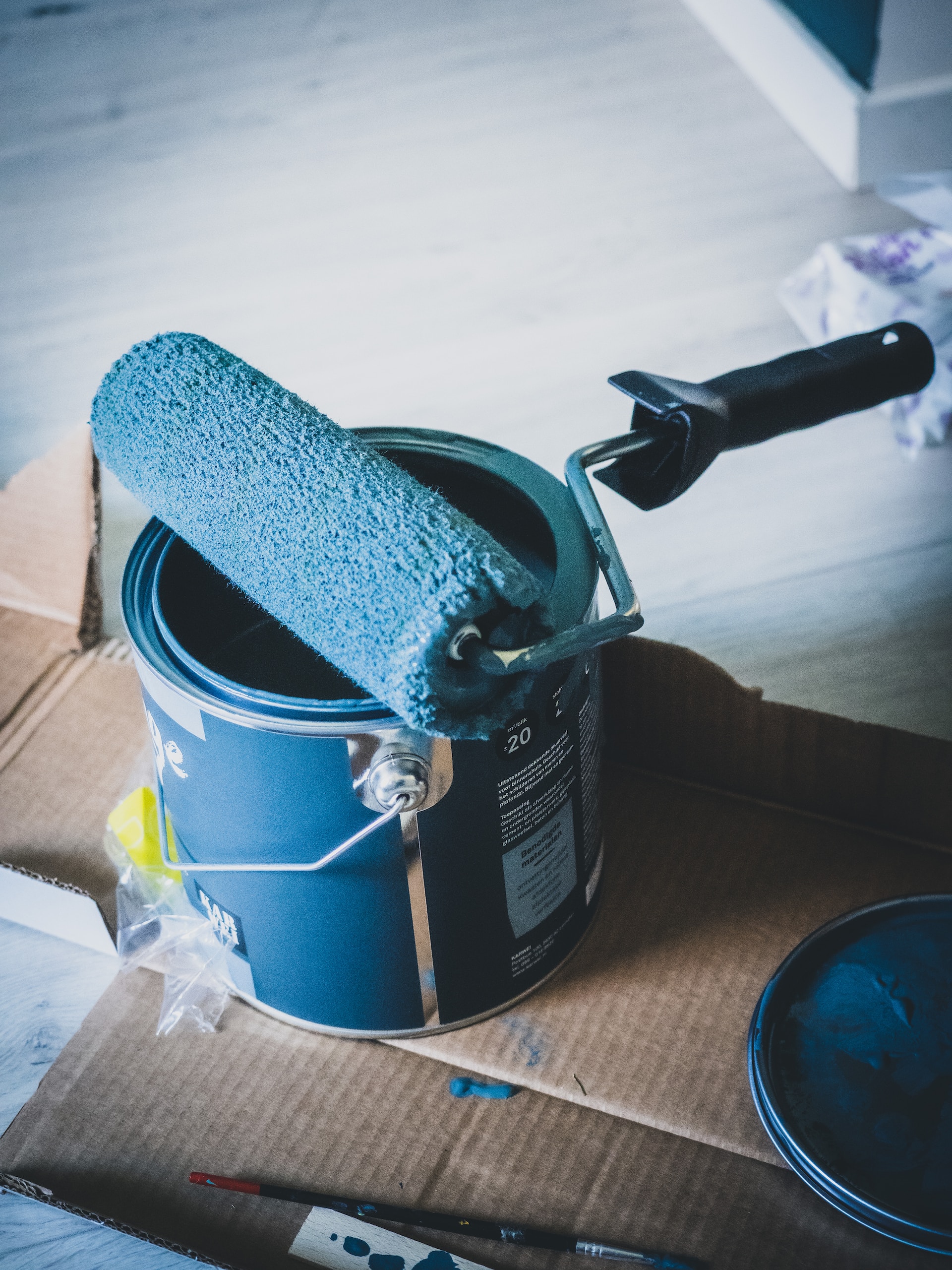
Paints have a rather complex and fascinating history. The first example of paint-making dates back to over 100,000 years ago in South Africa — an offshoot of mineral and organic-based pigments, mostly bone marrow, iron Oxide and charcoal. Our fascination with paints and the colors we can achieve with them have been with us since the dawn of time. Whether for indoor, and making that cave sparkle, or for outdoor use, to give our Babylonian mansion the right curb-appeal, we’ve always been enamored of paints. Choosing the right type of paint for your home is crucial as it not only affects the aesthetics but also determines the durability and protection of surfaces. Understanding the disparities between interior and exterior paints is essential in making informed decisions for your painting project.
Application and Coverage
In 1866, Sherwin-Williams started to dabble in industrial - right out of the tin - paints that could be used without any previous preparation. He was the forefather of all those vats of paints that now decorate the aisle of Home Depot. He might not have discovered paints, but he essentially made them into household items that any person could use without the need for a color specialist. Within his many contributions we can uncover the fact that he was one of the first paint-makers in the world to start separating, and in fact creating, two types of paints — one for indoor, the other for outdoor use.
Indoor Application
Interior paints are suitable for walls, ceilings, and surfaces within the house. They have been made with those criterias in mind. They provide excellent coverage for your home’s interior — usually requiring fewer coats, and they dry relatively quickly.
Types of Interior Paints
The world of interior paints encompasses a vast array of options. Each of these options offers distinct characteristics suited for different surfaces and preferences. Potential painters and or individuals who want to bring new life to their walls must understand these paint types. To come to terms with their composition, and how they are made — based on base, finish, and application. On how and why each element is picked in order to achieve the desired pigmentation and functionality within a space.
Based on Base
- Water-Based Paints: Paints, such as latex, acrylic, and PVA, are prevalent in interior use due to their user-friendly application, minimal odor, and rapid drying time. They are mostly employed for different types of surfaces and are easy to clean up.
- Oil-Based Paints: Although in vogue, these types of paints are less common for interior applications. Oil-based paints provide superior durability and resistance against stains and moisture. Nevertheless, they have some negatives to take into account — they possess a stronger odor and require a longer drying time.
Based on Finish
- Flat/Matte Paints: Flat/Matte paints provide excellent coverage and conceal imperfections. One of their drawbacks is that they are less durable and more prone to scuffs. Still, they work well in low-traffic areas like bedrooms and ceilings.
- Eggshell Paints: They offer a subtle sheen, and are more durable. Eggshell paints can endure light cleaning. They are suitable for spaces such as living rooms and hallways.
- Satin Paints: With a slightly higher sheen, satin paints offer good durability and cleanability. They are mostly used in areas that might see more moisture or require regular cleaning, like kitchens and bathrooms.
- Semi-Gloss Paints: Semi-gloss paints provide a moderate sheen and are highly durable and resistant to stains. They are an ideal choice for high-traffic areas like trims and doors.
- Gloss Paints: These types of paints offer the highest level of sheen and durability. Gloss paints are reflective and ideal for accent pieces, trim, and surfaces that require frequent cleaning.
Based on Application:
- Wall Paints: As the name says, wall paints have been carefully designed at a chemical level for interior walls. These paints offer excellent coverage and adhesion to various surfaces.
- Trim Paints: Designed for trims and molding, these types of paints have a smooth, durable finish. A finish that can withstand frequent cleaning and touch-ups.
- Ceiling Paints: Ceiling paints are formulated to provide good coverage with a flat finish, minimizing imperfections and glare.
- Primer Paints: Primers are applied before the topcoat. They are employed to enhance adhesion, block stains, and create a uniform surface for the paint to adhere to.
- Specialty Paints: within this subgroup we find paints that have been designed for specific applications, such as fire-resistant paints, mildew-resistant paints, and low-VOC paints aimed at improving indoor air quality.
Outdoor Application
Exterior paints, like the name decrees, are perfect for surfaces such as siding, trim, doors, and outdoor structures. They require thorough surface preparation and often necessitate multiple coats to ensure adequate protection. They have been carefully created to withstand all types of weather and harsh conditions — each brand, and each type, has different levels of resilience.
Types of Exterior Paints
Up until the Renaissance, exterior paints were more or less stuck on a technological plateau — they hadn’t evolved since the Egyptians, Greeks, and Romans were using them to protect their homes. Up until that period, they were functional at best. They were meant to endure and protect not enhance. Then, artisans and builders, during this enlightened era, began to experiment with different pigments, oils, and organic materials. They started creating more vibrant, attractive, and long-lasting colors. It was a huge evolutionary leap in the history of paints and one that maintains its momentum into the now.
Much like interior paints, exterior paints offer a diverse range of options each tailored to withstand outdoor conditions. They are also designed to provide a touch of magic and aesthetic appeal. Exterior paints are categorized based on base, finish, and specific properties. Coming to terms with these paint types is essential for preserving and enhancing the exterior surfaces of your home.
Based on Base
- Acrylic Latex Paints: Acrylic latex paints are favored due to their durability, flexibility, ease of application, and rapid drying time. They offer exceptional resistance to fading, cracking, and peeling, making them an ideal choice for exterior use.
- Alkyd Paints: Alkyd paints provide superior resistance to moisture and harsh weather conditions. They are sought out in areas known for extreme climate conditions.
- Silicone Alkyd Paints: These types of paints combine the durability and moisture resistance of alkyd paints with the flexibility and easy application of acrylic latex paints. They are a midway point between both options. — offering great balance and versatility for exterior surfaces.
Based on Specific Properties
- Waterproofing Paints: Waterproofed paints are designed to repel water and prevent moisture penetration. They are an essential tool for areas prone to rain or high humidity.
- Mildew-Resistant Paints: Containing fungicides that inhibit mildew and fungal growth, these types of paints are crucial for areas with high humidity or shade.
- UV-Resistant Paints: these paints have been formulated to protect against the sun's harmful UV rays — they prevent fading and premature deterioration of the paint finish.
- Low-VOC Paints: Low-VOC paints have been crafted to emit minimal volatile organic compounds, reducing indoor air pollution and promoting a healthier environment.
- Fire-Resistant Paints: Specifically designed to slow the spread of fire and protect against flame damage, particularly important for certain building materials and structures.
FAQ on Interior and Exterior Paints
What happens if I use interior paint for the exterior?
Each paint type is created for a specific and ideal situation — they have been chemically brainstormed into the now to serve a niche. There’s a reason why exterior paints are branded and marketed as such. Using interior paints for exterior surfaces will result in quicker deterioration due to its inability to withstand outdoor elements. It might lead to premature cracking, fading, and peeling. And using exterior paints for indoor uses, although some have their advantages, such as mildew-resistant paints for the bathroom, is a bit of an overkill.
Can I use exterior paint indoors?
While it's possible to use exterior paints indoors, they might emit higher levels of VOCs - volatile organic compounds - compared to their counterparts, which could affect indoor air quality. Additionally, exterior paints may take longer to dry indoors. If you’re hiring a professional, they will help you out and give you advice on what works and what doesn't —- certain paints, although marketed as exteriors, can be used for interiors, it all depends on the characteristics of the space in question.
Is there a difference in cost between interior and exterior paints?
Generally, exterior paints tend to be more expensive due to its specialized formulation and durable properties designed for outdoor use. This is one of the main reasons why DIY enthusiasts, looking to cut costs normally, make the costly mistake of selecting interior paints for outdoor uses.
Our Painting Services
At RenoTitan, we offer comprehensive painting services tailored to both interior and exterior surfaces. Our team specializes in selecting the right paint type, preparing surfaces meticulously, and providing flawless application, ensuring a professional finish, and lasting results.
Considering a painting project? Visit RenoTitan and let our experts guide you in choosing the suitable paint for your interior and exterior surfaces.
Understanding the distinction between interior and exterior paint is fundamental to achieving optimal results for your home. Whether it's enhancing indoor aesthetics or ensuring weather-resistant exteriors, choosing the right paint type is crucial. At RenoTitan, we prioritize quality and expertise to make your painting project a success.
About the author


